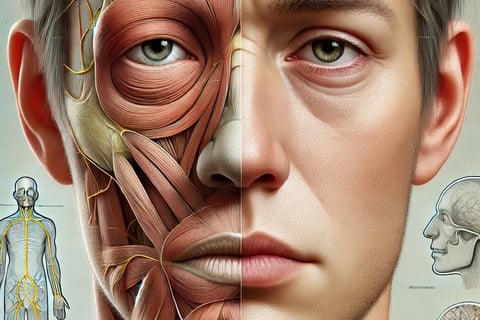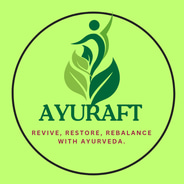

Facial palsy, also known as facial paralysis, is a condition where there is a loss of voluntary muscle movement in the face, typically due to damage or dysfunction of the facial nerve (cranial nerve VII). This condition can affect a person's ability to smile, blink, or perform other facial expressions. At Ayuraft, we integrate modern medical knowledge with Ayurvedic principles to offer a holistic approach to facial palsy.
Facial Palsy
Modern and Ayurvedic Aspects
1. Modern Aspects of Disease
Causes:
Bell’s Palsy: The most common cause, often linked to viral infections like herpes simplex virus.
Trauma: Injury to the facial nerve, either from accidents or surgery.
Infections: Ear infections or Lyme disease can contribute to facial palsy.
Stroke: A major cause of facial paralysis due to compromised blood flow to the brain.
Tumors: Growths pressing on the facial nerve can cause gradual paralysis.
Neurological Disorders: Conditions like multiple sclerosis (MS) can affect facial muscles.
Symptoms:
Sudden weakness or paralysis on one side of the face
Drooping of the mouth or eyelid
Inability to close the eye on the affected side
Difficulty smiling, frowning, or other facial expressions
Drooling, tearing, or dryness in the mouth or eyes
Diagnosis:
Physical Examination: To assess the extent of paralysis.
Imaging: MRI or CT scans to rule out stroke, tumors, or structural damage.
Nerve Conduction Tests: To assess the function of the facial nerve.
Treatment:
Medications: Corticosteroids, antiviral medications (for Bell’s palsy), and pain relievers.
Physical Therapy: Exercises to strengthen facial muscles.
Surgery: For nerve damage repair, decompression, or cosmetic correction in severe cases.
Botox: Sometimes used to address muscle tightness or asymmetry.
2. Ayurvedic Aspects of Disease
In Ayurveda, facial palsy is described as a Vata dosha disorder (imbalances in the nervous system). It is also referred to as Ardita and is often attributed to the aggravation of Vata, which affects the nerves and muscles.
Causes (Nidana):
Vata imbalance due to stress, improper diet, and lifestyle choices
Overexposure to cold weather or wind
Injury or trauma
Mental stress or anxiety
Excessive exertion or improper sleep habits
Symptoms:
Facial drooping, weakness, or paralysis
Difficulty in speech and facial movements
Dryness of the eyes or mouth
Tingling or numbness in the face
Disturbed sleep and irritability
Diagnosis:
Nadi Pariksha (Pulse Diagnosis): To assess the imbalance of doshas (especially Vata).
Detailed evaluation of lifestyle, diet, and environmental factors.
Treatment (Chikitsa):
Herbal Remedies: Herbs like Ashwagandha, Bala, and Rasna to pacify Vata and strengthen nerves.
Panchakarma:
Nasya (nasal therapy): To clear the channels and strengthen facial nerves.
Abhyanga (therapeutic oil massage): Warm medicated oils (like sesame oil) are used to massage the face and body, promoting circulation and balancing Vata.
Shirodhara: Pouring warm oil over the forehead to calm the nervous system and reduce stress.
Yoga and Pranayama:
Facial exercises to stimulate the muscles and nerves.
Breathing exercises like Nadi Shodhana and Bhramari Pranayama to balance the nervous system.
Dietary Modifications: A Vata-pacifying diet rich in warm, nourishing, and oily foods. Avoid cold, dry, and raw foods.
Ayurvedic Medications: Use of Dashamoola (a herbal formula) and other Vata-balancing medicines.
In Ayurveda, facial palsy (Ardita) is primarily considered a result of Vata imbalance that affects the nerves and muscles. Ayurvedic herbs and treatments aim to balance Vata, strengthen the nervous system, and restore muscle function. Below are some key Ayurvedic herbs used in the management of facial palsy, along with their properties and uses:
1. Ashwagandha (Withania somnifera)
Properties: Adaptogenic, anti-inflammatory, rejuvenative (Rasayana)
Benefits: Ashwagandha is widely used for its ability to reduce stress and improve nervous system function. It helps strengthen the muscles and restore nerve function, making it beneficial in conditions like facial palsy.
Usage: It is often taken as a powder (churna) or capsule with warm milk or water to balance Vata and enhance vitality.
2. Bala (Sida cordifolia)
Properties: Nervine tonic, anti-inflammatory, analgesic
Benefits: Bala strengthens the muscles and nerves, improving motor function in cases of paralysis. It is used to nourish and protect the nervous system, making it a valuable herb for treating facial palsy.
Usage: Bala can be used as part of Abhyanga (oil massage) therapy with medicated oils, as well as in oral formulations.
3. Dashamoola
Properties: Anti-inflammatory, Vata-balancing, pain-relieving
Benefits: Dashamoola is a classical Ayurvedic formulation made from ten medicinal roots. It is commonly used to treat disorders of the nerves and muscles, making it ideal for facial palsy. It reduces inflammation, pain, and Vata imbalance, while improving circulation and nerve function.
Usage: Taken internally as a decoction or included in therapeutic oils for external application.
4. Rasna (Pluchea lanceolata)
Properties: Anti-inflammatory, analgesic, Vata-pacifying
Benefits: Rasna is known for its ability to relieve pain and inflammation in Vata-related conditions like facial palsy. It improves joint and muscle health, and its anti-inflammatory properties help in alleviating nerve dysfunction.
Usage: Used in both internal and external therapies, such as herbal decoctions or as part of Panchakarma treatments.
5. Guggulu (Commiphora mukul)
Properties: Anti-inflammatory, detoxifying, Vata and Kapha balancing
Benefits: Guggulu is used to reduce inflammation and detoxify the body, which helps in the recovery of nerve function. It also supports tissue regeneration and is often used in formulations for nerve-related conditions like paralysis.
Usage: Typically taken in tablet form or as part of Ayurvedic formulations like Yograj Guggulu.
6. Nirgundi (Vitex negundo)
Properties: Anti-inflammatory, analgesic, muscle relaxant
Benefits: Nirgundi is a powerful herb for managing pain, inflammation, and muscle stiffness. It is often applied externally as an oil or used in steam therapies to reduce Vata imbalances and improve muscle tone in facial palsy patients.
Usage: Used as an herbal oil for massage or in decoctions to relieve stiffness and enhance nerve health.
7. Shankhapushpi (Convolvulus pluricaulis)
Properties: Nervine tonic, anti-stress, Vata-balancing
Benefits: Shankhapushpi is known for its calming and Vata-balancing effects on the nervous system. It is helpful in reducing stress, improving cognitive function, and restoring nerve health, which is crucial for facial palsy recovery.
Usage: Typically used in powdered form, mixed with honey or milk, and consumed to strengthen the nervous system.
8. Brahmi (Bacopa monnieri)
Properties: Neuroprotective, adaptogenic, anti-anxiety
Benefits: Brahmi is a renowned brain tonic that helps in rejuvenating the nervous system, improving memory, and restoring nerve function. It is particularly useful in conditions like facial palsy where nerve regeneration is essential.
Usage: Consumed as powder or capsules, often with ghee (clarified butter) for improved absorption.
9. Eranda (Ricinus communis)
Properties: Anti-inflammatory, analgesic, Vata-pacifying
Benefits: Eranda (castor oil) is used in both internal and external therapies to reduce Vata imbalance. It helps improve joint and nerve health, making it beneficial for treating paralysis and nerve dysfunction in facial palsy.
Usage: Eranda oil can be applied externally in oil massages or consumed in small amounts to promote Vata balance and relieve nerve issues.
10. Pippali (Piper longum)
Properties: Digestive, anti-inflammatory, rejuvenative
Benefits: Pippali is often used to enhance digestion and improve nutrient absorption, which is vital for overall recovery in facial palsy. It also acts as a rejuvenative for the nervous system, promoting nerve healing.
Usage: Pippali is often combined with other herbs in formulations like Trikatu or taken as a powder mixed with honey.
Ayurvedic Therapies Along with Herbs
Panchakarma: Ayurvedic detox therapies such as Nasya (nasal administration of medicated oils) and Shirodhara (pouring oil over the forehead) are commonly used to treat facial palsy. These therapies help clear blocked channels, improve circulation, and balance Vata.
Abhyanga: A daily oil massage with medicated oils like Mahanarayan or Dhanvantari oil helps to nourish the nerves, improve circulation, and strengthen facial muscles.
These Ayurvedic herbs and treatments aim to balance the body’s doshas, improve nerve health, and promote natural healing.
At Ayuraft, we provide a comprehensive treatment plan combining modern diagnostic techniques and Ayurvedic therapies for effective management and recovery from facial palsy. The goal is not only to treat the symptoms but to address the root cause of the Vata imbalance to promote long-term wellness.
ayuraft.com© 2024. All Rights Reserved.
DISCLAMER: All information provided on this website is not intended to diagnose,prevent treat or cure any disease.Always consult a licensed medical professional for your health condition. READ MORE..
By using,readig or accessing any page on this website,you agree that you have read, understood and will abide by the terms and conditions of USE,DISCLAMER and PRIVACY POLICY.


